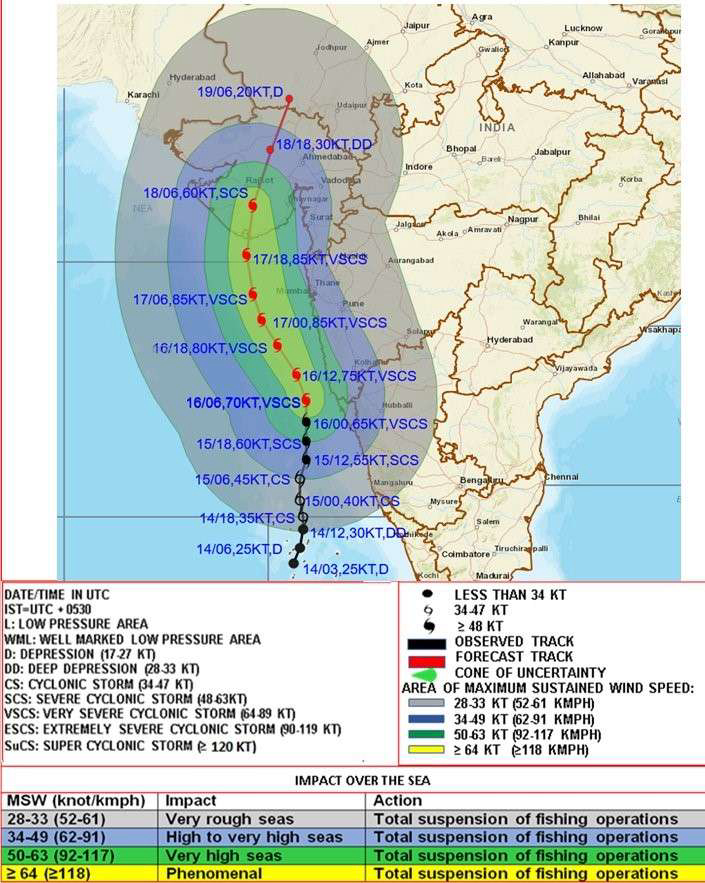
Cyclones are one of the most dangerous natural phenomena. It is generally caused by atmospheric disturbance, and it is a structure of wind rotating inwards around a low-pressure area, accompanied by severe weather conditions like storms. And presently, a deep depression over the Arabian sea has exaggerated into a cyclonic storm named ‘Tauktae’. The cyclone Tauktae will be a certainly risky cyclonic storm from May 16 to 18, and so, more than 50 teams of the National Disaster Response Force (NDRF) are on duty in the coastal regions of states like Kerala, Karnataka, Tamil Nadu, Gujarat, and Maharashtra.
Tauktae is very likely to intensify further into a severe cyclonic storm during the next 6-12 hours. Red and orange alerts have been declared by officials in various parts of India. When the speed of a storm wind reaches or crosses 74 mph then it is considered to be a Cyclone, and only when a storm becomes a cyclone, it is given a name. Meteorological Centre at Bhubaneswar has said that the name ‘Tauktae’ has been given by Myanmar which means ‘gecko’, meaning a highly vocal lizard in Burmese. And this Tauktae is going to be the first cyclonic storm of this year along the Indian coast. Such Tropical Cyclone is officially named by one of its warning centers spread across the globe under the guidance of the World Meteorological Organization (WMO). This practice of naming cyclones began to identify the storms in cautioning messages. It is difficult to remember technical numbers and terms of the cyclones for people. So, to increase the alertness of people in case of cyclones like Tauktae and to make it easier to spared information these cyclones are given names.

According to the Indian Meteorological Department (IMD), the Tauktae cyclone is very likely to cross the Gujarat coast between Porbandar and Naliya around May 18. It indicates that it will move north or north-westwards and cross the coast of Gujarat around afternoon or evening on 18th May. Current forecasts by the IMD have indicated heavy rainfall in Junagadh and Gir Somnath and average to extreme rain in Saurashtra, Devbhoomi Dwarka, Amereli, Rajkot, Kutch, and Diu. Tauktae is also likely to cause rainfall of different intensities, in parts of Rajasthan and Tamil Nadu too. IMD uses the Global Forecast System model (GFS), and it has indicated the cyclone could make rainfall over Gujarat, between Porbandar and Naliya. However, contrary to this forecast, the European Centre for Medium-range Weather Forecast model (ECMFW) has forecasted a more eastward, closer-to-coast track as compared to the IMD, in which the cyclone Tauktae may make landfall around some parts of Gujarat while packing 118-165 kmph speed. If this prediction turns out to be true, India’s west coast may likewise witness more heavy rainfall and wind than the current forecast indicates.
Heavy storms additionally with the Tauktae have formed severe falls, aggressive winds, and large waves in different coastal parts of India. It has created immense chaos in Kerala, as it smashed the state government to shift hundreds of families to relief camps. The cyclone also claimed two lives in Ernakulam and Kozhikode districts of Kerala and forced more than 2000 to move to 71 relief camps. Some netizens have also uploaded videos of the effects Tauktae cyclone.
In Mumbai, the BMC took different precautionary measures after IMD’s warning of the Tauktae cyclone. It included shifting of 580 patients from its huge COVID-19 facilities, with the shutdown of Bandra-Worli Sea Link for around two days. Regions affected by Tauktae saw widespread waterlogging, uprooting of trees, and disruption of property and power supply. Presently, a control room has started with full functioning after IMD’s indications in Gujarat as well. District collectors of some coastal regions in Gujarat have been asked to take precautionary measures, and the NDRF teams have also arrived there.
In the wake of the Tauktae cyclone alert, Prime Minister Narendra Modi has gone over the preparations of states, and concerned agencies and asked them to ensure all the people who can be affected are safely evacuated, with all other suitable precautions. The Indian Air Force’s two C-130 J aircraft airlifted 3 NDRF teams including 126 staff and equipment from Bhubaneshwar to Jamnagar for safety measures. Officials have also advised people to be prepared with some primary health kits, battery backups, lamps, and other essential things. People have also been warned against going out to take photos and videos or swim in any floodwaters. Citizens are also asked to store enough food, water, and medications for the next three days, specifically in the coastal regions where cyclone Tauktae can hit.
___________________________________________________
Reference:
- www.mausam.imd.gov.in
- www.weather.com
